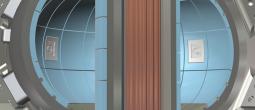

Reactor Simulation Overview

The reactor simulator manages the production of the vast majority of the vessel's energy using nuclear fusion. The simulator is made up of four major systems, including systems for the creation and management of high-temperature plasma which fuels the reaction and two systems which manage the magnetic fields containing the plasma.
The reactor is divided into eight segments, with most systems managed on a per-segment basis. The plasma drive system is the exception - it manages plasma flow characteristics across segments and throughout the entire reactor simulator.
The reactor simulation is made up of four key systems. The current version (four) of the simulation is intended as a minimum viable product (MVP) for testing simulation systems and principles prior to launch. The approach assumes increased complexity will be added after launch using the simulation design engine.
A guide to the conventions used with simulation systems can be found here.
Toroidal Containment System
Toroidal Field Generators (TGEN) are powerful super-conducting magnets that create the main magnetic field for containing the high-temperature plasma that fuel the fusion systems within the reactor simulation. There are eight toroidal generators surrounding the reactor with the portion of the reaction chamber falling between a facing pair of toroidal generators creating a reactor segment.
The toroidal containment system manages the output of these generators against power input into them. A number of factors impact the efficiency of this power response profile, most notably power loading.
While the toroidal field generators are constructed using coils of ‘room-temperature’ superconductors, this material is highly efficient only within a certain band of power input. Generator efficiency is also impacted by higher temperatures caused by excess radiant heat from the reactor chamber, so despite the term 'room-temperature' superconductor, generator temperatures are managed by a tertiary cooling system to ensure efficient operation.
The main output from the toroidal containment system is Applied Toroidal Force (ATF) which describes where within the magnetic field's pressure gradient that plasma containment occurs.
Sub-Systems
The toroidal containment system is supported by a number of sub-systems which have their own power management and control requirements. As such, only the outputs of these sub-systems are referred to in the main system. Separate articles cover the operation of these sub-systems:
Tertiary Cooling System
[STUB]
Poloidal Containment System
Poloidal Field Generators (PGEN) manipulate the main containment field to optimise plasma flow characteristics with carefully-tuned complementary magnetic fields, using the principles of magnetic field dynamics.
The poloidal generation system manages the output of these generators against power input into them. As the poloidal containment field needs to be significantly less powerful than the toroidal field to be effective, operating temperature efficiencies are of little concern.
The main outputs from the poloidal containment system are (in conjunction with the toroidal system) the Active Field Plane Focus (AFPF) which determines where in the reaction chamber the ATF manifests, thereby describing the shape and position of the containment field.
The other output is the Containment Field Pitch (CFP) which describes the extent of distortions to the AFPF caused by the shape and direction of magnetic fields changing as they move further from their generators. Too much distortion to the AFPF can impact plasma flows, significantly reducing reaction efficiency and potentially causing magnetohydrodynamic (MHD) instabilities. Serious instabilities could cause the reactor to stall (drop below ignition) or even damage the reactor chamber itself.
Reactor Plasma System
The reactor plasma system is the most complex in the reactor sim. It manages the efficiency of the reaction and its ability to remain self-sustaining.
Fuel plasma must have external energy added to it to induce fusion reactions between the hydrogenic particles making it up. Energy must keep being added until the energy produced by fusion exceeds that lost by radiation. The inflection point reflecting this is referred to as reaction ignition.
Three factors contribute to the reactor's ability to reach ignition and remain self-sustaining: plasma temperature, density and confinement time.
The main output of the plasma system is plasma temperature, which is transferred by the primary coolant loop for power generation.
Sub-Systems
The plasma system is supported by a number of sub-systems which have their own power management and control requirements. As such, only the outputs of these sub-systems are referred to in the main system. Separate articles cover the operation of these sub-systems:
Reaction Ignition System
The Reaction Ignition System adds external energy to fuel plasma to bring the reaction up to ignition, after which it becomes self-sustaining, rearing no additional external energy to maintain fusion reaction.
Plasma Fuel Injection System
[STUB]
Reactor Chamber Vacuum System
[STUB]
Plasma Drive System
The Plasma Drive System manages the magnetohydrodynamic (MHD) characteristics of plasma within the reaction. In particular, maintaining nominal plasma flows around the tokamak is important to avoid instabilities within the plasma and to ensure the plasma interacts correctly with the containment field.
Failure to maintain nominal MHD characteristics may lead to a number of engineering events with impacts ranging from reduction in reaction efficiency to serious physical damage to the reactor chamber.
The Plasma Drive System is relatively simple, with few complex components or interactions. It is the only reactor system that uses engineering events, however.
Reactor Chamber
The Reactor Chamber System manages the transfer of thermal energy from the reaction to the coolant system. As a byproduct, the system also manages the external Environmental Heat Load (EHL) for the toroidal containment system.
Sub Systems
Reactor Isolation System (RIS)
This sub-system represents the 'blanket' system that lines the interior of the reactor chamber, absorbing thermal and radiation energy. The system is made up of double-layered modules, with each layer processing either thermal (RISTM for RIS Thermal Module) or radioactive (RISRM for RIS Radiation Module) energy.
This system is intended to record degeneration over time caused by reaction temperature and MHD events. The modules will need to be replaced once degeneration reaches a certain level. This level of complexity has not been included in the MVP.
Coolant System
The reactor's Coolant System is responsible for the transfer of thermal energy from the reaction to generate steam, which is used by a turbine generator to produce electrical power. The system is made up of two closed loops, which ensures that radiation from the reactor is isolated from the generator and radiator arrays (which dissipate excess heat into space).
Because of its relative complexity the coolant system is not include din the reactor simulation schematic below. A separate schematic can be found on the system page.
Sub Systems
Primary Coolant Loop
The Primary Coolant Loop transfers thermal energy from the reactor to a heat exchanger. This is a closed loop which isolates reaction radiation from the rest of the coolant system.
Secondary Coolant Loop
The Secondary Coolant Loop uses thermal energy from the primary loop to generate steam, which is directed to the generator. The secondary loops takes output steam from the generator and cools it using space-facing radiator arrays, so that it can be looped back into the thermal exchange for steam generation.
Generator
The Generator is technically a sub-system of the secondary coolant loop but is documented separately to reduce complexity. The generator concentrates steam from the secondary loop and uses it to run a turbine, which produces electrical power for the vessel.








